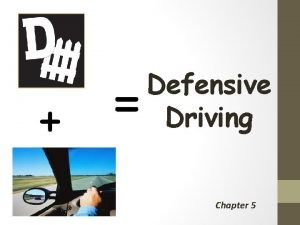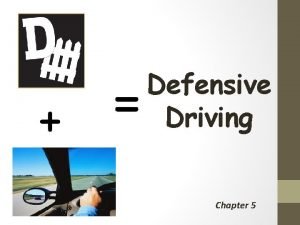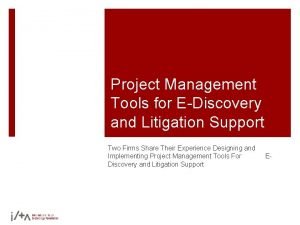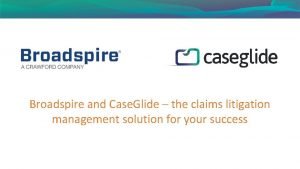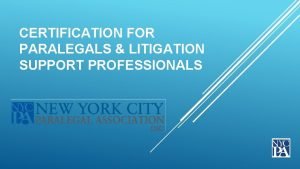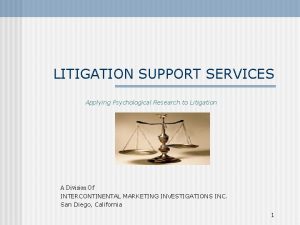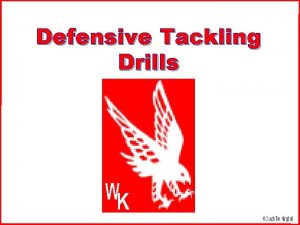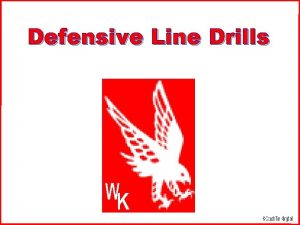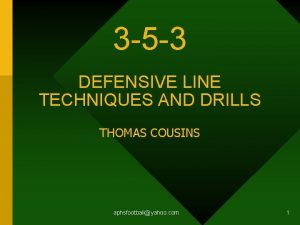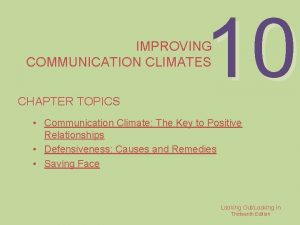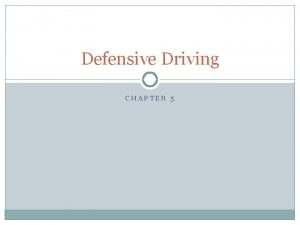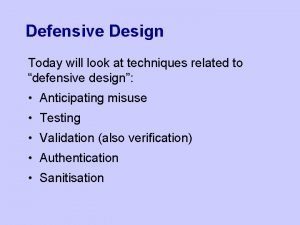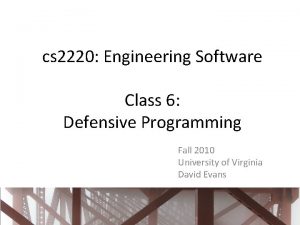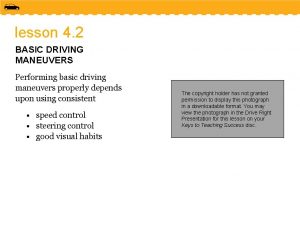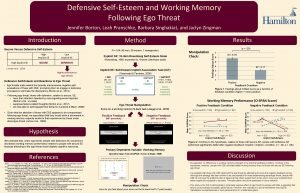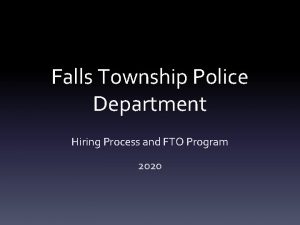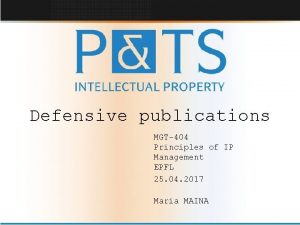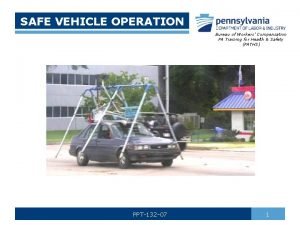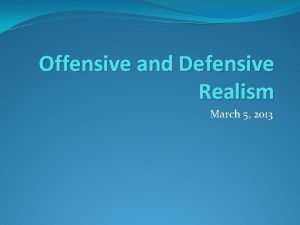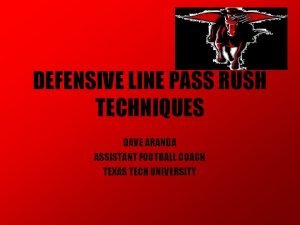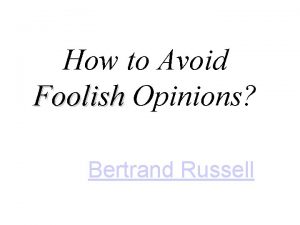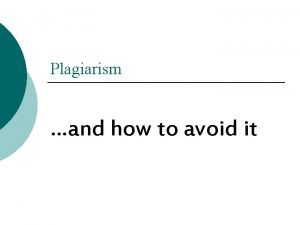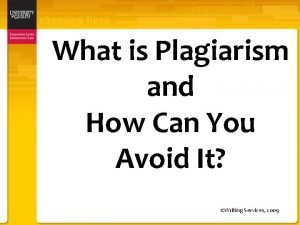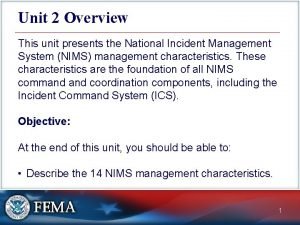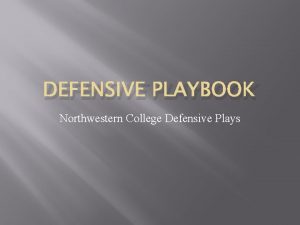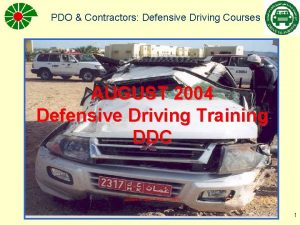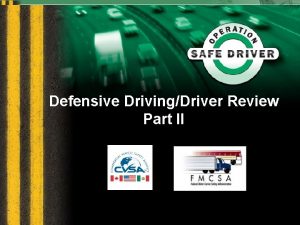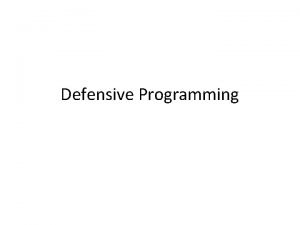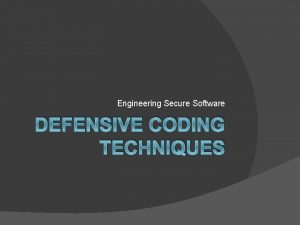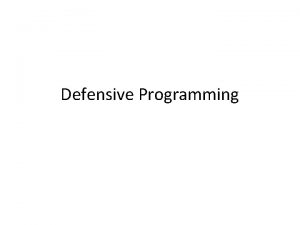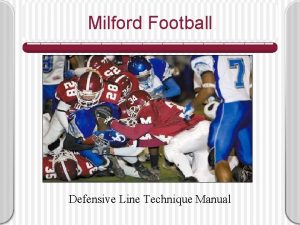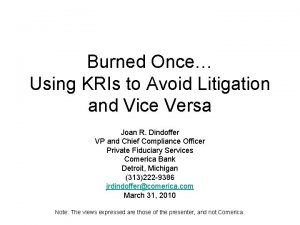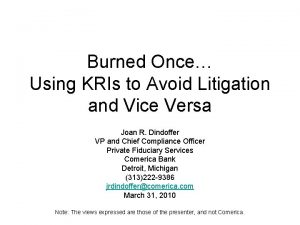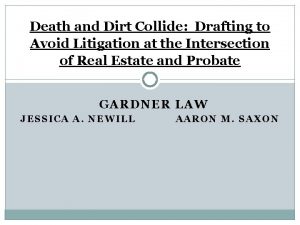Defensive Strategies to Avoid Litigation and When Litigation







































- Slides: 39

Defensive Strategies to Avoid Litigation and When Litigation is Unavoidable Jennise Walker Stubbs Kelsey Copeland


General Tips to Avoid Litigation • Determine risk (regulatory and litigation) • Do not be static – look for ways to improve risk profile on continuous basis • Stay abreast of trends in law and litigation • Assess risk and dispose of it quickly before litigation ensues

To Avoid Litigation: Assess Risk • When is the most important time to assess risk? v Entry into new industry or market v New contract or business relationship v Acquisition of company

To Avoid Litigation: Assess Risk • Due Diligence • Understanding emerging litigation trends • Understanding regulatory and compliance issues v FDA, FTC, CPSC, USDA, NAD, NITSA, FAA, etc. • Analyzing current risks with existing contracts / products v Insurance coverage

Assess Risk – Regulatory Compliance • Regulatory compliance review (daily, weekly, monthly, yearly): v Current state of the business • Currently maintaining compliance? • Identify potential compliance “hazards”

Assess Risk – Regulatory Compliance • How to analyze? v Speak with company employees v Review documents v Compare with regulatory requirements

Assess Risk – Regulatory Compliance • New business / market / contract v Identify governing regulations and standards v Identify status of compliance v Identify compliance “hazards” • Examples: v Retail store seeking to become a food establishment v Development and marketing of new products

Assess Risk – Regulatory Compliance • Risks associated with non-compliance: v Fines v Revocation of license v Cessation of operations v Civil litigation v Criminal prosecution

Assess Risk – Due Diligence • Research every aspect of a deal to assess potential liability • Leaving no stone unturned

Assess Risk – Due Diligence • Example: Acquisition of a medical device manufacturing company v Assessed every product the company designed/manufactured v Assessed regulatory obligations v Assessed regulatory compliance and risk v Assessed litigation liability on a state and federal level

Assess Risk – Due Diligence • Acquisition of a medical device manufacturing company (cont’d) • Determined regulatory status of products (compliance and obligations going forward): v 510(k) vs. PMA devices v Quality system requirements v Medical device reporting requirements v Recall, correction, and removal requirements v Medical device tracking requirements v Postmarketing surveillance studies

Assess Risk – Due Diligence • Acquisition of a medical device manufacturing company (cont’d) • Analysis of civil liability related to medical devices generally and specifically v Analysis of the law of the home state of the purchaser and the company to be purchased v Analysis of potential defenses available in those states and specific defenses available for manufacturers of the specific devices v Analysis of potential damages for these types of claims

Assess Risk – Due Diligence • Acquisition of a medical device manufacturing company (cont’d) • Summary and analysis of overall risk of acquisition based upon regulatory issues, product liability law, and number of adverse events / recalls / prior litigation

Assess Risk – Due Diligence • Other examples: v Medical device raw material supplier becoming brand device manufacturer v Chemical company seeking to provide raw materials to product manufacturer

Sometimes, litigation is unavoidable.

You’ve been sued. Now what? • Obtain dismissal immediately v Insufficient pleadings v No personal jurisdiction v No subject matter jurisdiction v Expiration of statute of limitations v Statutory grounds v Improper joinder / misjoinder v Preemption

You’ve been sued. Now what? • Obtain dismissal later • Exclusionary motions / challenges to experts • Summary judgment • Change jurisdiction • Remove to federal court • Change venue

Dismissal Strategies: Insufficient Pleadings • Motion to Dismiss v Rule 91 a (Texas) • Unknown – attorneys’ fees v FRCP 12(b)(6) • Re-pleading permitted • Special exceptions

Dismissal Strategies: Personal Jurisdiction • Daimler, AG v. Bauman, 571 U. S. ___ (2014) • A state court has general personal jurisdiction over a corporation if the state is the: place of incorporation and principal place of business

Dismissal Strategies: Personal Jurisdiction • Bristol-Myers Squibb v. Superior Court of California, 582 U. S. ___ (2017) • A state court’s specific jurisdiction cannot be conferred by acts within a state that are unrelated to the specific plaintiff’s cause of action • Example: Talc litigation

Dismissal Strategies: Subject Matter Jurisdiction • Federal court subject matter jurisdiction • Standing of plaintiff to sue • Ripeness • Mootness • Sovereign immunity • Can’t be waived

Dismissal Strategies: Statute of Limitations • When did the plaintiff know, or when should the plaintiff have known, about the injury at issue? • Different SOLs for different states (keep choice of law in mind)

Dismissal Strategies: Preemption • Supremacy Clause of the Constitution: Article VI, Clause 2: v This Constitution, and the laws of the United States which shall be made in pursuance thereof; and all treaties made, or which shall be made, under the authority of the United States, shall be the supreme law of the land; and the judges in every state shall be bound thereby, anything in the Constitution or laws of any State to the contrary notwithstanding.

Dismissal Strategies: Preemption • Express preemption • When Congress has adopted a statute that explicitly displaces state law • Example— 21 U. S. C. 360 k(a) (Medical device amendments to FDCA): • No state. . . may establish or continue in effect with respect to a device intended for human use any requirement (1) which is different from, or in addition to, any requirement applicable under this chapter to the device, and (2) which relates to the safety or effectiveness of the device. .

Dismissal Strategies: Preemption • Implied preemption • When federal law occupies the entire regulatory “field, ” leaving no place for state law or • When state law would “conflict” with federal law, either because simultaneous compliance with federal and state law is impossible or because state law thwarts the federal statutory scheme

Dismissal Strategies: Preemption • Examples of conflict preemption: v PLIVA, Inc. v. Mensing, 564 U. S. 604, 618 (2011) • Impossibility preemption: Failure-to-warn claims against generic drug manufacturers are impliedly preempted; it is impossible for generic drug manufacturers to comply with state tort law while also complying with federal law v Sikkelee v. Precision Airmotive Corp. , 822 F. 3 d 680, 70304 (3 d Cir. 2016) • Impossibility preemption applied to airplane manufacturer based on FAA regulations

Dismissal strategies: Improper Joinder / Misjoinder • Multi-plaintiff cases: v Do the claims arise out of the same transaction or occurrence? • Plant explosion vs. product liability claims

Dismissal Strategies: Statutory Grounds • Example: Biomaterials Access Assurance Act (“BAAA”) • 21 U. S. C. § 1601, et seq. : Biomaterials suppliers are immune from liability in personal injury actions under certain circumstances (1) Establish defendant qualifies as “biomaterials supplier” (2) Negate liability as a manufacturer (3) Negate liability as a seller (4) Negate liability for failure to meet contractual requirements

Dismissal Strategies: Summary Judgment • Establish that there are no material issues of fact • FRCP 56; TRCP 166 a and 166 a(i)

Dismissal Strategies: Challenging Experts • Expert testimony required when issues are beyond the understanding of an average layperson • File expert exclusionary motion to establish that (1) the expert is not qualified; (2) the testimony is not based on a reliable foundation; or (3) the expert’s methodology was flawed

Other Options: Removal to Federal Court • Federal question jurisdiction • Diversity jurisdiction

Other Options: Removal to Federal Court • Diversity Jurisdiction: • Complete diversity of citizenship between Plaintiff and Defendant; $75, 000 amount in controversy • Fraudulent joinder / misjoinder • Then, use dismissal techniques discussed previously to obtain diversity jurisdiction • Issues to think about: • Voluntary / involuntary rule • One year rule

Be Aware: Current Litigation Trends • Post terror attack litigation v 1993 World Trade Center bombing: New York Port Authority initially found liable v 9/11: manufacturers of airplanes sued • Diesel exhaust v Emissions monitoring suits • Automobile patent litigation • Fidget spinners

Current Litigation Trends • Consumer class actions v Shipping fees v New Jersey Truth in Consumer Contract, Warranty and Notice Act (YES, it may apply to Texas companies) • Water-related litigation v Chloramine v PFOA/PFOS v Lead exposure

Current Litigation Trends • Contamination / Exposure – insurance litigation v Benzene, arsenic, MTBE, vapor intrusion • Agricultural run offs and residues • Antitrust v Water treatment chemical manufacturers

Current Litigation Trends • Hydraulic Fracturing v Contaminates of drinking water v Releases toxic chemicals v Induces earthquakes v Generates pollution • Water access

Final Thoughts • Identify and eliminate risk that may lead to litigation, among other things – whether through in-house counsel or outside counsel • If litigation ensues, have a full understanding of the legal weapons at your disposal that will give you the upper hand

Questions?
 To avoid collisions a defensive driver should
To avoid collisions a defensive driver should To avoid collisions a defensive driver should
To avoid collisions a defensive driver should Litigation project management
Litigation project management Case glide
Case glide Association of litigation support professionals
Association of litigation support professionals Research & litigation support
Research & litigation support Defensive interval ratio
Defensive interval ratio Defensive driving toolbox talk
Defensive driving toolbox talk Michigan state police teenage defensive driving
Michigan state police teenage defensive driving Defensive interval ratio
Defensive interval ratio Open field tackling drill
Open field tackling drill Defensive end contain drills
Defensive end contain drills Defensive driving facts
Defensive driving facts Chapter 5 defensive driving quiz answers
Chapter 5 defensive driving quiz answers Defensive behaviors can escalate in any order
Defensive behaviors can escalate in any order Defensive line fundamentals
Defensive line fundamentals Types of communication climate
Types of communication climate Defensive driving nevada
Defensive driving nevada Unitary actor realism
Unitary actor realism Defensive driving training course ppt
Defensive driving training course ppt Most accidents are caused by _________ driving error.
Most accidents are caused by _________ driving error. Two examples of defensive design
Two examples of defensive design Defensive programming java
Defensive programming java Non defensive learning
Non defensive learning Imitive
Imitive Turnabout driving definition
Turnabout driving definition Defensive self esteem
Defensive self esteem Crisis development model directive staff approach
Crisis development model directive staff approach Contoh sikap obstruktif dalam perusahaan
Contoh sikap obstruktif dalam perusahaan Police defensive tactics
Police defensive tactics Defensive publication example
Defensive publication example Rua defensive driver
Rua defensive driver What is defensive realism
What is defensive realism What is the ipde defensive driving formula
What is the ipde defensive driving formula Garland manufacturing
Garland manufacturing Dave aranda defense playbook
Dave aranda defense playbook How to avoid foolish opinions bertrand russell
How to avoid foolish opinions bertrand russell What is plagiarism and how to avoid it
What is plagiarism and how to avoid it What is plagiarism and how can you avoid it
What is plagiarism and how can you avoid it To avoid overburdening the incident command resources
To avoid overburdening the incident command resources
